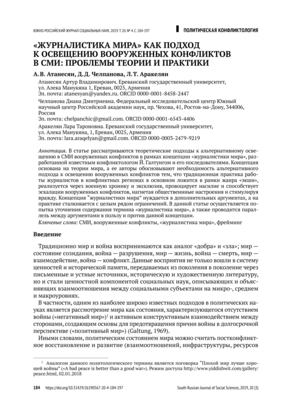Abstract
Alternative approach to cover armed conflicts in Mass Media developed in frames of “Peace journalism” by Johan Galtung and his followers, is discussed in this paper. The concept itself is based on Peace Studies, and justified by the precondition that traditional Media framing of armed conflicts based on sensations, search for exclusive materials, and demonstration of battlefield with visualization of violence, used to be provocative and might contribute to further escalation of a conflict through cultivation of enmity in the societies involved. This is the main reason why the common approach to Media coverage of armed conflicts in frames of “action” is proposed to be replaced by “Peace journalism”, which also needs to be clarified as a concept, within its specific as well as common techniques. The concept of “Peace journalism” itself still needs additional argumentation, and often meets various limits of technical as well as conceptual nature. In the paper an attempt to clarify the content of “Peace journalism” as well as to illustrate the pros and contras of the concept, is presented.
Keywords
References
Атанесян, А.В. (2019). “Бархатная революция” в Армении: потенциал, достижения и риски политикопротестной активности. ПОЛИС. Политические исследования, 6, 80–98. DOI: https://doi.org/10.17976/jpps/2018.06.06
Герасимович, О.П. (2014). Конфликтология журналистики. Минск: БГУ.
Коноваленко, М.Ю., Коноваленко, В.А. (2016). Теория коммуникации: учебник для академического бакалавриата. М.: Издательство Юрайт.
Мележик, К.А. (2016). Интерпретация смысла в межнациональной коммуникации на английском языке. Российский гуманитарный журнал, 5(4), 394–402.
Олейников, С.В. (2015). Миротворческий потенциал и язык конфликта современной журналистики. Вестник СПбГУ, 9(2), 208–215.
Якова, Т.С. (2018). “Мирная журналистика” в противодействии терроризму. Электронный научный журнал “Медиаскоп”, 3. Режим доступа http://www.mediascope.ru/2477
Brüggemann, M. (2014). Between Frame Setting and Frame Sending: How Journalists Contribute to News Frames. Communication Theory, 24(1), 61–82. DOI: 10.1111/comt.12027
Dijkzeul, D. (2008). Towards a Framework for the Study of “No War, No Peace” Societies. Working Paper 2, Swiss Peace, April.
Dimitrova, D.V., Strömbäck, J. (2008). Foreign Policy and the Framing of the 2003 Iraq War in Elite Swedish and US Newspapers. Media, War & Conflict, 1(2), 203–220. DOI: 10.1177/1750635208090957
Entman, R.M. (2003). Cascading Activation: Contesting the White House’s Frame After 9/11. Political Communication, 20, 415–432. DOI: 10.1080/10584600390244176
Evans, M. (2010). Framing International Conflicts: Media Coverage of Fighting in the Middle East. International Journal of Media and Cultural Politics, 6(2), 209–233. DOI: 10.1386/mcp.6.2.209_1
Galtung, J. (1969). Violence, Peace and Peace Research. Journal of Peace Research, 6(3), 167–191.
Gerbner, G., Gross, L., Morgan, M., Signorielli, N. (1986). Living with Television: The Dynamics of the Cultivation Process. In J. Bryant and D. Zillmann (Eds.). Perspectives on Media Effects (pp. 17–40). Lawrence Erlbaum Associates, Hillsdale, N.J.
Hallahan, K. (1999). Seven Models of Framing: Implications for Public Relations. Journal of Public Relations Research, 11(3), 205–242.
Irvan, S. (2006). Peace Journalism as a Normative Theory: Premises and Obstacles. GMJ: Mediterranean Edition, 1(2), 34–39.
Laplante, L.J., Phenicie, K. (2009). Mediating Post-Conflict Dialogue: The Media’s Role in Transitional Justice Processes. Marquette Law Review, 93(1), 251–283.
Lederach, J.P. (1998). Building Peace. Sustainable Reconciliation in Divided Societies. Washington, D.C.: United States Institute of Peace Press.
Lynch, J. (2015). Peace journalism: Theoretical and methodological developments. Global Media and Communication, 11(3), 193–199. DOI: 10.1177/1742766515606297
Matthes, F. (2008). Need for Orientation as a Predictor of Agenda-Setting Effects: Causal Evidence from a Two-Wave Panel Study. International Journal of Public Opinion Research, 20(4), 440–453. DOI: 10.1093/ijpor/edn042
McCombs, M.E., Shaw, D.L., Weaver, D.H. (2014). New Directions in Agenda-Setting Theory and Research. Mass Communication and Society, 17(6), 781–802. DOI: 10.1080/15205436.2014.964871
McGoldrick, A., Lynch, J. (2000). Peace Journalism: What is it? How to do it? Reporting the World. Retrieved from https://www.transcend.org/tri/downloads/McGoldrick_Lynch_Peace-Journalism.pdf
Moy, P., Tewksbury, D., Rinke, E.M. (2016). Agenda-Setting, Priming, and Framing. In J.K. Bruhn and R.T. Craig (Ed.). The International Encyclopedia of Communication Theory and Philosophy (pp. 1–13). John Wiley & Sons, Inc. DOI: 10.1002/9781118766804.wbiect266
Mogekwu, M. (2011). Conflict Reporting and Peace Journalism: in Search of a New Model. Lessons from the Nigerian NigerDelta Crisis. In I.S. Shaw, J. Lynch, and R.A. Hackett (Ed.) Expanding Peace Journalism: Comparative and Critical Approaches (pp. 239–260). Sydney University Press.
Orgeret, K.S. (2016). Conflict and Post-Conflict Journalism Worldwide Perspectives. In K.S. Orgeret and W. Tayeebwa (Eds.) Journalism in Conflict and Post-Conflict Conditions Worldwide Perspectives. University of Gothenburg, Nordicom.
Puddephatt, А. (2006). Voices of war: Conflict and the role of the media. International Media Support. Retrieved from https://www.mediasupport.org/wp-content/uploads/2012/11/ims-voices-of-war‑2006.pdf
Scheufele, D.A. (1999). Framing as a Theory of Media Effects. Journal of Communication, 49(1), 103–122. DOI: 10.1111/j.1460–2466.1999.tb02784.x
Scheufele, D.A. & Tewksbury, D. (2007). Framing, Agenda Setting, and Priming: The Evolution of Three Media Effects Models. Journal of Communication, 57, 9–20.
Somerville, K. (2017). Framing Conflict — the Cold War and after: Reflections from an Old Hack. Media, War & Conflict, 10(1), 48–58. DOI: 10.1177/1750635217698336
Shinar, D. (2007). Independent Media and Peace Journalism. In S. Celenk (Ed.) Another Communication is Possible (pp. 179–185). İstanbul: IPS Foundation. Retrieved from http://bianet.org/system/uploads/1/files/attachments/000/001/522/original/Another_communication_is_possible.pdf?1447151794
Yang Lai Fong, N. (2009). Framing Analysis of a Conflict: War / Peace Journalism. SEARCH: The Journal of the South East Asia Research Centre for Communications and Humanities, 1(1), 17–32.


